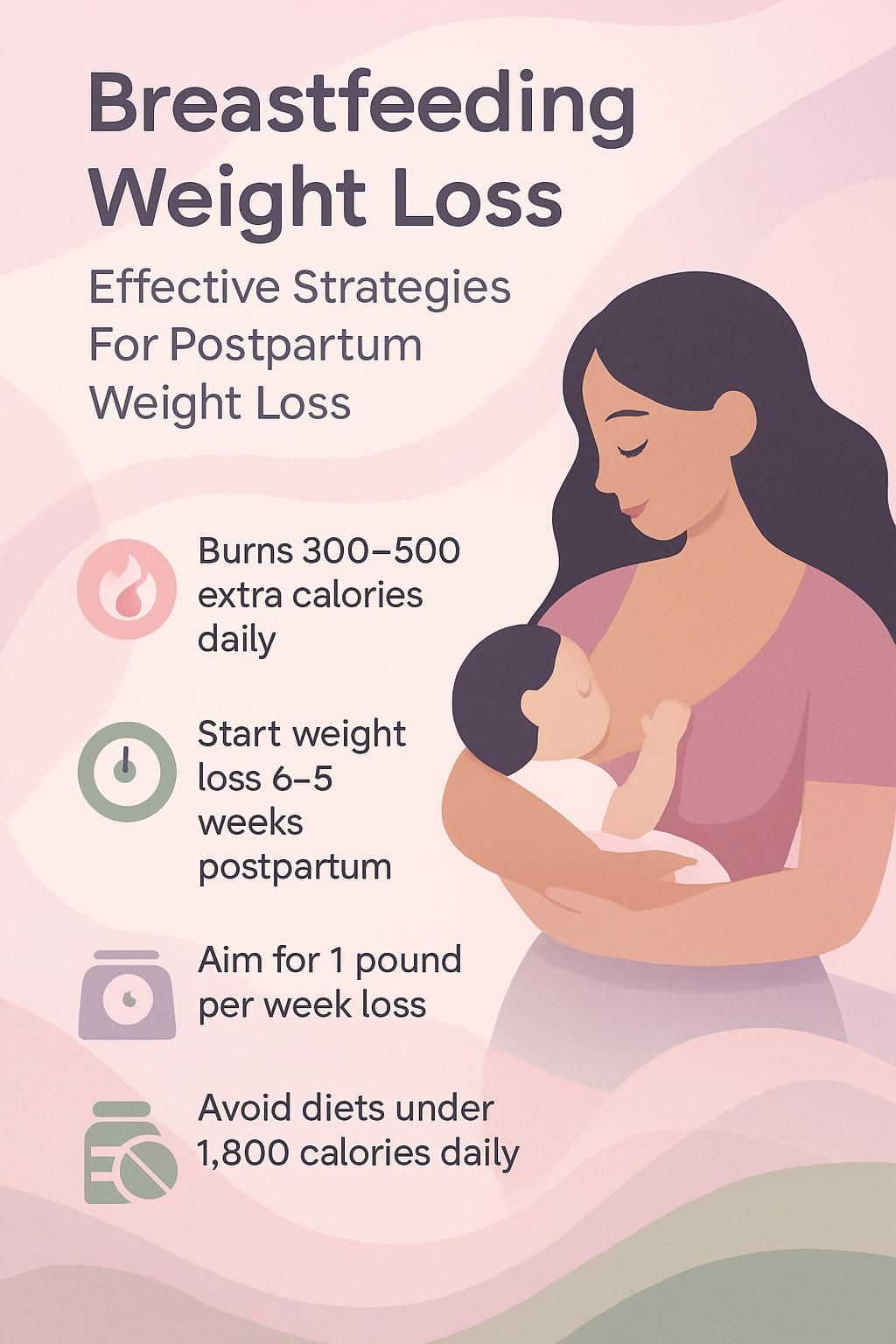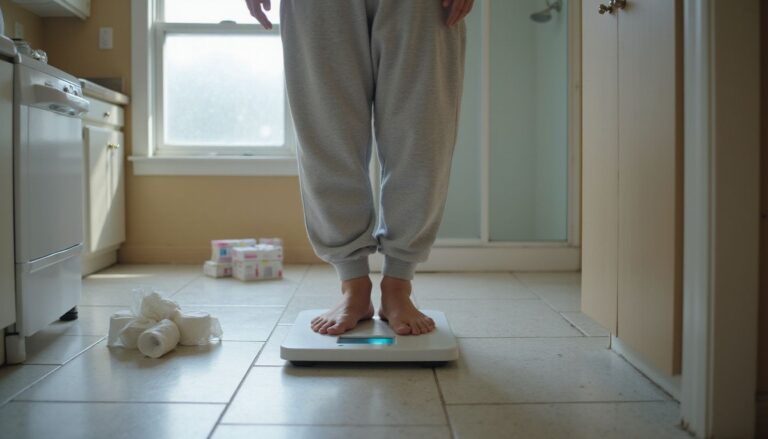Breastfeeding Weight Loss: Effective Strategies For Postpartum Weight Loss
Our Nutrition Assistant AI Suite will transform your body. You will lose fat, get toned, and build muscle. Gain confidence and optimal health.
You may be eager to shed extra pounds after childbirth yet unsure where to begin. Breastfeeding weight loss is real for many mothers, though speed and results vary. Research suggests nursing uses about 300 to 500 calories per day, which can support a return to your pre-pregnancy weight.
In this guide, you will learn how the effect of breastfeeding supports postpartum weight loss. You will also get clear steps for healthy eating, safe exercise, and realistic goals that fit life with an infant.
See what truly works for breastfeeding mothers who want to lose weight while breastfeeding without hurting milk supply.
Key Takeaways
- Breastfeeding uses about 300 to 500 extra calories daily. Studies, including those in Obstetrics and Gynecology, report greater postpartum weight loss within the first year for women who breastfeed exclusively.
- Start active weight loss around 6 to 8 weeks after birth, unless your clinician advises otherwise. Aim for about 1 pound, or 0.5 kg, per week. Avoid very-low-calorie diets under 1,800 calories per day during lactation.
- Moderate activity like walking or yoga is usually safe near six weeks postpartum. Research shows it does not reduce milk supply if calorie needs are met.
- Exclusive breastfeeding during the first six months can raise calorie use up to about 500 calories per day, which may support ongoing fat loss.
- Most weight loss medications and many supplements are not approved during lactation. Safety data are limited, so experts recommend avoiding them while nursing.

How Does Breastfeeding Influence Weight Loss?

Your body works hard to make breast milk. That work uses energy, which can help with weight control during the postpartum period.
How Does Breastfeeding Affect Weight Loss?
While making milk, your body taps stored fat for fuel. That process, called lactation, can support slow weight loss during the months after birth. Many studies estimate an energy cost of about 300 to 500 calories per day for milk production.
Mothers who breastfeed exclusively often lose more pregnancy weight than those who mix feed or use formula. Research in Obstetrics and Gynecology found that women who breastfed exclusively had greater weight loss within the first year postpartum.
Hormones like prolactin, which drives milk production, can also affect appetite and metabolism. You may feel hungrier at times. Body mass index, or BMI, usually declines gradually as calorie needs rise for milk production and you add gentle activity with a balanced diet.
How Many Calories Does Breastfeeding Burn?
The number depends on your body size, activity level, and whether you breastfeed exclusively. On average, producing breast milk burns about 300 to 500 calories a day. The American Academy of Pediatrics notes that exclusively breastfed infants receive all their nutrition from human milk in the first six months. That can raise your daily energy needs even more than mixed feeding.
If you choose whole foods and limit processed snacks, this calorie use can aid postpartum weight loss while you keep your nutrition strong. A food diary and simple activity log can help you spot patterns that support steady progress.
I noticed changes within a few weeks of nursing my daughter. I did not cut calories too hard, and my weight moved down bit by bit each month.
Best Time to Begin Postpartum Weight Loss
The right start time depends on healing, energy, and how feeding is going. A gentle approach protects your recovery and your infant’s needs.
When Is It Safe to Start Losing Weight After Birth?
For most mothers, it is best to wait until your milk supply is steady before you actively try to lose weight. Many start gentle changes about 6 to 8 weeks after childbirth, if there are no complications. The American College of Obstetricians and Gynecologists supports a gradual plan.
Aim for about 1 pound each week. Choose nutrient-dense foods such as whole grains, vegetables, fruits, lean proteins, and calcium-rich snacks. Avoid very-low-calorie diets, especially under 1,800 calories per day while nursing, unless your clinician is supervising.
Always check with your healthcare provider before major changes to eating or exercise while breastfeeding.
Why Is Establishing Milk Supply Important Before Weight Loss?
Your body needs energy to make breast milk, especially in the first 6 to 12 weeks. Cutting calories too soon can lower milk output or reduce key micronutrients. Some women notice a fussy baby or shorter feeds when intake drops fast.
I tried trimming meals too early and my baby fussed more at the breast. Shifting back to balanced meals brought quick improvements for both of us.
Build a strong milk supply first. It supports your health and your baby’s growth during this crucial window.
Slow changes support safe postpartum weight loss. Next, create a mild calorie deficit without risking nutrition or milk supply.
Safe and Effective Weight Loss Strategies While Breastfeeding
Aim for steady progress, not quick fixes. These steps protect your energy, milk production, and long-term health.
How to Create a Gradual Caloric Deficit?
A small, steady calorie gap works better than drastic cuts. It preserves milk supply and avoids fatigue.
- Estimate daily calorie needs with a calculator that includes age, height, activity level, and lactation. Target a modest deficit of about 300 to 500 calories per day.
- Track intake with a journal or app. Many new mothers underestimate calories after childbirth, which can stall progress.
- Fill your plate with nutrient-dense foods. Choose whole grains, fruits, lean protein, and colorful vegetables to support recovery and milk quality.
- Avoid very-low-calorie plans under 1,800 calories per day while nursing, unless guided by a clinician or dietitian. Severe restriction can reduce milk supply and raise fatigue.
- Swap sugary drinks for water or unsweetened herbal tea. Lactating women need about 3 liters, roughly 13 cups, of fluids per day.
- Weigh in weekly, using the same scale and time of day. Weekly trends matter more than daily swings.
- Speak with your healthcare provider if you have nausea, diarrhea, pain, or other symptoms while adjusting your diet.
After my first baby in New York City, replacing soda with water and adding protein at lunch made a clear difference. I kept my energy up and still watched the scale move.
What Are Nutrient-Dense Foods to Choose?
Nutrient-dense foods deliver vitamins, minerals, and protein without extra empty calories. They help with weight control and support milk supply.
- Choose whole grains like brown rice, oats, and quinoa for steady energy and fiber to curb hunger.
- Include fruits such as berries, oranges, apples, or bananas for vitamins and hydration. Aim for at least two servings daily.
- Add a variety of vegetables, including leafy greens, carrots, broccoli, and bell peppers, to boost fiber and essential nutrients.
- Select lean proteins like chicken, turkey, eggs, beans, or fish rich in omega-3 fats to aid tissue repair and fullness.
- Pick low-fat dairy options such as yogurt or cheese for calcium. Bone density can dip during lactation.
- Snack on nuts or seeds, like almonds or chia, for healthy fats and lasting energy.
- Focus on fresh foods more than packaged snacks to limit added sugars and unhealthy fats.
- Drink water throughout the day, which supports metabolism and milk production.
- Limit foods high in saturated fat or added sugar, which promote fat gain without good nutrition.
Planning two or three simple meals ahead makes busy days easier and reduces last-minute fast food choices.
How Much Water Should You Drink While Breastfeeding?
Most experts suggest about 3.2 liters, or around 13 cups, of fluids daily during lactation. Making breast milk increases your fluid needs. Thirst and dark urine can signal that you need more water.
Keep water within reach during feeds and sip often. Skip sugary beverages and soda, which add calories without helping your goals.
Exercise Guidelines for Breastfeeding Moms
Movement can lift your mood, steady your energy, and help trim weight after childbirth.
When Can You Start Exercising After Delivery?
Many providers clear mothers for structured exercise at the six-week visit, especially after an uncomplicated birth. Gentle walking and stretching can start sooner for many people if you feel comfortable.
Light activity improves circulation and mood without harming milk supply. I began short walks about one week after delivery and slowly increased time as my body allowed.
Research, including work by Stuebe and colleagues, suggests moderate activity is safe around 6 to 12 weeks postpartum, once you feel ready and have medical clearance. Stop and rest if you have pain, bleeding, or heavy fatigue.
What Exercises Are Best for New Mothers?
Start with low-impact choices that protect healing tissues and support daily tasks with your baby.
- Walking burns calories with minimal joint stress and fits into most schedules.
- Pelvic floor exercises, known as Kegels, help prevent leaks and support core function.
- Light stretching improves flexibility and eases muscle tension.
- Swimming or water aerobics provide gentle resistance and protect joints.
- Postnatal yoga builds core strength, posture, and relaxation.
- Bodyweight moves, like squats or modified push-ups, add functional strength.
- Resistance bands allow safe strength work with easy intensity changes.
- Dance-based classes lift your heart rate and mood in a fun way.
- Short, easy cycling sessions support heart health with low fatigue.
- Stroller walks or light jogs let you exercise while your baby rides along.
These activities support recovery and weight control while you protect milk supply and joint health.
What Are the Benefits of Physical Activity While Breastfeeding?
Exercise can boost energy, lower stress, and support gradual fat loss. Studies show moderate activity does not reduce milk volume or quality if you meet your calorie and fluid needs.
Even 20 minutes helps. For example, a brisk morning walk with a stroller can set a positive tone for the day.
Check with your clinician before major training changes, especially if you take any medicine or consider oral weight loss medications.
Diet Tips for Breastfeeding Mothers
Food choices shape your energy, recovery, and milk production. Small, steady changes lead to better results.
What Are Balanced Meal Ideas for Nursing Moms?
Balanced meals combine whole grains, protein, produce, and healthy fats. Here are simple ideas you can rotate each week.
- Oatmeal with berries and a boiled egg provides fiber, antioxidants, and protein.
- Whole grain turkey sandwich with avocado, lettuce, and tomato offers complex carbs and healthy fats.
- Brown rice stir-fry with mixed vegetables and tofu or shrimp delivers vitamins and complete protein.
- Greek yogurt with banana and chia seeds supplies calcium, potassium, omega-3s, and probiotics.
- Grilled salmon with broccoli and sweet potatoes provides omega-3s and vitamin C.
- Lentil soup with whole wheat crackers adds plant protein and iron. Toss in fresh spinach.
- Roasted chicken with quinoa and mixed greens covers protein and fiber in one plate.
- Smoothie with spinach, frozen berries, flaxseed, yogurt, and water hydrates and nourishes.
- Scrambled eggs with tomatoes and spinach gives protein plus vitamins A and K.
- Hummus with whole-wheat pita and carrot sticks offers iron-rich chickpeas and complex carbs.
Meals like these kept me fueled through long feeds and helped me avoid big energy dips.
Which Foods Should Be Avoided While Breastfeeding?
Some foods and drinks can affect milk or infant health. Limiting them helps with safe postpartum weight loss.
- High-mercury fish such as shark, swordfish, king mackerel, and tilefish.
- Alcohol. If you choose to drink, speak with your clinician about timing and safety.
- Too much caffeine. Try to keep intake under 300 milligrams per day.
- Highly processed foods with lots of sugar or unhealthy fats.
- Extreme low-carbohydrate diet plans, such as an Atkins-style approach.
- Herbal weight loss supplements, unless your healthcare provider approves them.
- Unpasteurized dairy and deli meats due to infection risk, such as listeria.
Focusing on whole grains, fruits, and vegetables makes meal planning easier and more satisfying.
Why Are Whole Grains, Fruits, and Vegetables Important?
These foods supply vitamins, minerals, fiber, and steady energy. They also help control hunger, which supports safe weight loss.
For example, fruits add vitamin C and antioxidants. Whole grains provide B vitamins and fiber. Over time, these choices may lower risks of heart disease and type 2 diabetes.
I kept bowls of fresh berries ready for quick snacks between feeds. That simple swap helped me avoid sugary treats when I felt tired.
Fad Diets and Breastfeeding Safety
Trendy plans can promise fast results, yet many do not fit the needs of lactation. Protect your energy and supply first.
Are Low-Carb Diets Safe While Nursing?
Strict low-carb diets can drop calories and key nutrients too much. Your body relies on carbs for energy, and cutting them too low may lower milk supply. Many experts suggest at least 210 grams of carbohydrates per day while nursing.
Some studies using advanced matching methods point to nutrition risks with very strict low-carb plans during lactation. Choose whole grains, fruits, and vegetables to keep energy stable and supply steady.
Is Intermittent Fasting Safe During Breastfeeding?
Most clinicians do not recommend intermittent fasting while nursing. Long gaps without food can lower energy and may reduce milk production. Fasting can also raise dehydration risk.
Focus on regular meals and snacks with nutrient-dense foods. The Academy of Nutrition and Dietetics also notes that weight loss medications are generally unsafe during breastfeeding, which supports a cautious approach.
Supplements and Weight Loss Medications Safety
Quick fixes can sound appealing in the early months. Safety for you and your baby comes first.
Are Weight Loss Medications Safe During Breastfeeding?
Most prescription weight loss drugs lack safety data for nursing mothers. Medicines like phentermine, orlistat, or semaglutide may pass into milk and affect infant health, so the FDA has not approved them for lactation.
I felt pressure to bounce back fast, yet my doctor advised against pills while I was nursing my son. There was not enough research on infant exposure through breast milk.
Focus on lifestyle steps until you finish breastfeeding. Talk with your provider before starting any medication or supplement.
What Are the Risks of Weight Loss Supplements and Shakes?
Dietary supplements are not regulated as strictly as prescription drugs in the United States. Some products contain hidden stimulants, contaminants, or undeclared ingredients. These can reach your baby through milk.
Herbal blends or high caffeine can disrupt infant sleep. Some protein shakes include artificial sweeteners or sugar alcohols that are poor choices while nursing.
Whole foods are safer and more effective for steady results. If you consider any supplement, ask your clinician first.
When Should You Consult a Healthcare Provider?
Seek help if you have sudden weight loss, persistent fatigue, hair thinning, brittle nails, dizziness, headaches, or low milk supply. These can signal a nutrition gap or another condition.
Report any side effects if you tried a supplement or medication. Ask about options if weight loss has stalled or if your baby is not gaining well.
Additional Tips for Successful Postpartum Weight Loss
Small habits stack up. Think of these as guardrails that keep you moving in the right direction.
How Does Sleep and Rest Impact Weight Loss?
Too little sleep shifts hormones that control hunger and fullness. Cortisol and ghrelin rise, while leptin falls, which can raise appetite and slow metabolism. Adults often need at least 7 hours per night for better weight control.
Short naps help if nights are broken. I noticed cravings spike when I slept under 6 hours, and exercise felt harder the next day.
Good sleep supports appetite control, milk supply, and steady energy for activity.
How Can You Manage Stress While Losing Weight?
Stress can push eating off track and drain motivation. Simple tools lower stress and help you stay consistent.
- Practice deep breathing or mindfulness for a few minutes daily.
- Take short outdoor walks with your baby for light movement and fresh air.
- Connect with friends, lactation consultants, or online groups for support.
- Set aside 10 minutes for an activity you enjoy, like reading or music.
- Ask for help with meals, chores, or errands to reduce overload.
- Eat regular meals with protein and whole grains to steady blood sugar.
- Set small weekly goals and celebrate progress you can feel.
- Limit caffeine if stress or sleep are issues.
How to Set Realistic Weight Loss Goals?
Right-sized goals reduce pressure and build momentum. They also protect milk supply.
- Aim to lose 1 to 2 pounds per week. The Centers for Disease Control and Prevention considers this pace safe for most adults, including many breastfeeding mothers.
- Use specific, time-bound goals. For example, lose 10 pounds in three months, not just get back to pre-pregnancy weight.
- Track weekly with a journal or app. Note meals, workouts, mood, and sleep.
- Celebrate small wins, such as cooking a healthy dinner or taking a daily walk.
- Adjust timelines if breastfeeding changes your pace. Every body responds differently after pregnancy.
- Review goals with your healthcare provider or a lactation specialist to support supply and health.
- Measure success by energy, strength, and mood, not only by the scale.
Breastfeeding Duration and Exclusivity Effects
How long and how exclusively you breastfeed can shape weight trends across the first year postpartum.
How Does Longer Breastfeeding Affect Weight Loss?
Breastfeeding for more months can support greater weight loss after childbirth. Your body keeps using calories to make milk, even as your baby starts solids. Exclusive breastfeeding can add about 400 to 500 calories of daily energy use.
Research in the American Journal of Clinical Nutrition links longer breastfeeding with lower body fat compared to stopping earlier. Many mothers see the most change between three and six months if they pair feeding with balanced meals.
Hormones involved in milk production also help your body tap stored fat for fuel. If you move to mixed feeding early, daily milk volume may drop, which can reduce this effect.
What Is the Difference Between Exclusive and Mixed Feeding?
Exclusive feeding means your baby receives only breast milk for the first six months, with no formula, water, or solids. Mixed feeding combines breastfeeding with formula or earlier solids.
Groups such as the World Health Organization recommend exclusive breastfeeding for six months for optimal nutrition and immune support. Mothers who feed exclusively often report more consistent postpartum weight loss than those who mix feed.
Common Myths About Breastfeeding and Weight Loss
Myths can set false expectations. Clear facts make planning simpler and kinder to your body.
What Are Common Misconceptions About Breastfeeding Weight Loss?
One myth says breastfeeding guarantees fast weight loss. Results vary due to genetics, diet quality, and activity. Another myth suggests you can eat anything and still lose weight. Calorie balance still matters.
Breastfeeding often burns 300 to 500 calories daily. Healthy eating and regular movement are still needed for change you can measure.
Is “Instant” Weight Loss After Birth a Myth?
You may see a quick drop right after delivery, from the baby, placenta, and fluids. That is usually 10 to 15 pounds during the first week.
The fat gained during pregnancy is more stubborn because your body saves it for milk production. Most mothers lose weight slowly over months, about 1 to 2 pounds weekly with good food choices and activity. Crash diets can harm milk supply and slow healing.
When Should You Seek Professional Help?
Support can shorten the learning curve and protect your health. Ask early rather than waiting.
When to Consult a Dietitian or Lactation Specialist?
Reach out if your weight loss stalls, your milk supply drops, or you notice fatigue, hair changes, or other signs of deficiency. Seek help if your baby is not gaining well despite frequent feeds.
Personal guidance on meal planning, allergies, or supplement safety can make daily life easier and more predictable.
How to Recognize Weight Loss Plateaus and Challenges?
If your weight holds steady for two or more weeks, you may be in a plateau. Clothes feel the same, and motivation can dip. This is common as metabolism adapts to fewer calories.
Track waist, hips, and other measures, not just weight. I hit a plateau six weeks postpartum that lasted almost a month. Adjusting sleep and adding one more walk per week helped break the stall.
Conclusion
Breastfeeding can support postpartum weight loss, especially when paired with smart habits. Focus on steady changes in diet, regular activity, and enough rest. Choose nutrient-dense foods, drink water, and protect your milk supply while you lose weight while breastfeeding.
If hurdles appear, talk with your healthcare provider or a lactation expert. Medical advice is essential for safety, especially if you consider supplements or medicines. Your pace may be slow at times, yet consistent steps often lead to lasting results for both you and your baby.
FAQs
1. How does breastfeeding help with postpartum weight loss?
Breastfeeding uses extra calories, which can support gradual weight reduction after childbirth. Research shows that nursing may burn about 300 to 500 calories per day, depending on the frequency and duration of feeding (Institute of Medicine, 2005). This calorie use helps many mothers lose pregnancy-related body fat over time.
2. What are effective strategies for safe postpartum weight loss while breastfeeding?
Focus on balanced meals rich in whole grains, lean proteins such as poultry or fish, fruits, and vegetables. Aim for slow and steady progress; losing one to two pounds per week is considered safe by most health experts (Centers for Disease Control and Prevention). Staying hydrated also supports milk production and overall wellness.
3. Can dieting affect breast milk supply during postpartum weight loss?
Severe calorie restriction or skipping meals may lower your energy levels and reduce milk output. Studies suggest that consuming at least 1,800 calories daily helps maintain adequate lactation (American Academy of Pediatrics). Prioritize nutrient-dense foods rather than cutting too many calories quickly.
4. Is exercise recommended while trying to lose weight when breastfeeding?
Moderate physical activity like walking or swimming is generally encouraged once cleared by a healthcare provider. Exercise combined with healthy eating can improve mood and aid in gradual fat reduction without harming milk quality or volume (Dewey et al., 1993).
Summary: Breastfeeding supports natural calorie burning after birth; combining it with nutritious food choices and moderate movement promotes healthy postpartum slimming without risking infant nutrition or maternal well-being.







